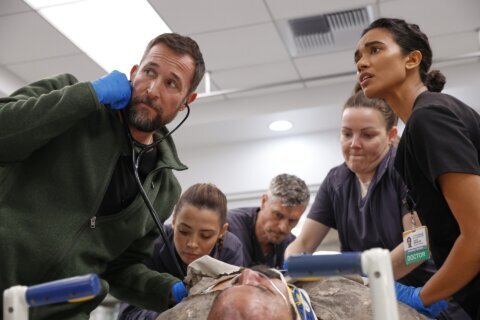About 71% of Earth’s surface is covered by water, so it deserves love on Earth Day.
You can celebrate by reading National Geographic’s new hardcover book “Ocean: A Global Odyssey” by Dr. Sylvia Earle, who is also president and chairman of Mission Blue.
“The world is blue, no ocean, no life,” Earle told WTOP. “It isn’t just the rocks and water. The ocean is alive. That’s what I hope that you will take away from diving into this book about the ocean. It’s a living system that makes our existence possible.”
Ironically, more than 80% of the ocean has never been mapped or seen.
“Unlike outer space, the ocean is alive,” Earle said. “Even in a cupful of water, there may be not just thousands but millions of extremely tiny but extremely important creatures, bacteria, even viruses that are responsible for shaping the nature of the ocean into a system that makes Earth habitable. It’s a chemistry that is shaped by life in the ocean.”
You can see this visually illustrated in the two-inch-thick book.
“My favorite part of the book is the big foldout that illustrates the many variations of animals, plants and little guys that make Earth habitable for us,” Earle said. “National Geographic is noted for bringing to the public some of the best images that have ever been developed … as well as maps that show major features … plus stories of the explorers.”
Underwater explorers are discovering all sorts of wildlife.
“The greatest era of exploration is just beginning,” Earle said. “I have a friend who dives into the twilight zone where the illuminated ocean meets eternal darkness. Richard Pyle at the Bishop Museum in Hawaii has discovered more than 13 new kinds of fish per hour … [and] variations of squid, octopuses and jellyfish that look like aliens.”
The goal is stress the urgency of human impact on the planet.
“We know that just in the past few decades, human actions have altered the nature of the ocean to a dangerous level,” Earle said. “Going forward, protection of the ocean is critical, not just to protect the fish, whales, coral reefs and kelp forests, but also by protecting them, we’re securing our own future. … Our very existence depends on it.”
The two big culprits are climate change and pollution.
“Sea-level rise is a visible consequence of the warming planet, of melting polar ice,” Earle said. “Warm water occupies more space than cold water, so the ocean is expanding as the planet warms. It’s fundamental that all creatures, including humans, are sensitive to a limited temperature regime. Change the temperature, you change basically everything.”
What specific damage are we already seeing?
“We’re changing forests of the ocean where phytoplankton can survive,” Earle said. “Half of the coral reefs have already disappeared or are in a state of serious decline largely because of the changes in temperature. … Also, our exploitation of ocean wildlife, taking too much out of the ocean, and putting too much in [with] a focus on plastic pollutants.”
She says the next decade is critical if we’re going to turn things around.
“The health of the ocean has declined significantly just in the decades that I have been a witness,” Earles said. “The next 10 years have a magnified importance. … The good news is that we know what we’re doing. Imagine if we didn’t know? We’re armed with knowledge, so we can make different decisions and have a long and prosperous future.”
Listen to our full conversation here.








